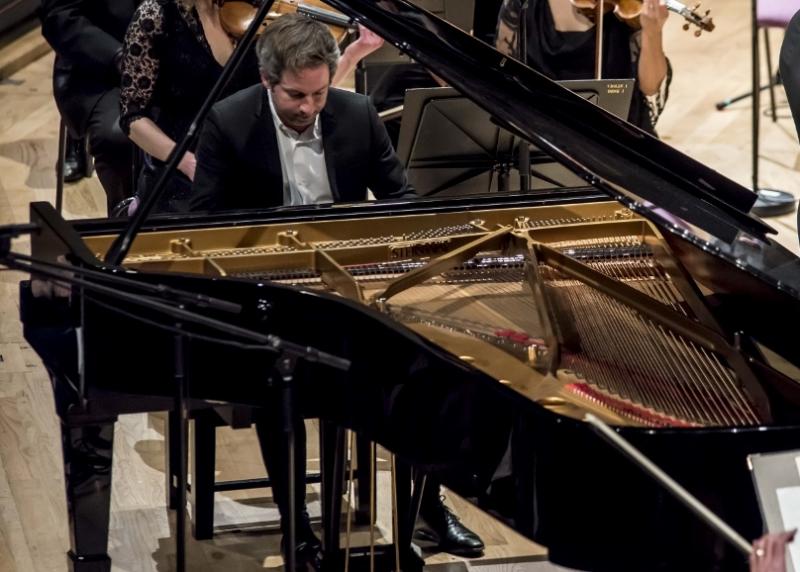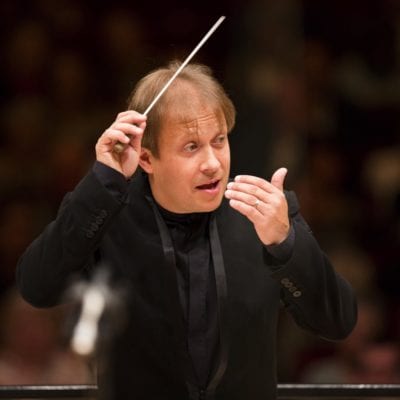Chamayou, BBC Philharmonic, Morlot, Bridgewater Hall, Manchester review - one-hand pianist as heroic overcomer | reviews, news & interviews
Chamayou, BBC Philharmonic, Morlot, Bridgewater Hall, Manchester review - one-hand pianist as heroic overcomer
Chamayou, BBC Philharmonic, Morlot, Bridgewater Hall, Manchester review - one-hand pianist as heroic overcomer
Ravel and Boulez celebration continued in big bangs and gentleness

The second of the Philharmonic’s Boulez-Ravel celebrations (birth centenary of the former, 150th of the latter) brought Bertrand Chamayou back: after his performance of the G major piano concerto in January, this time it was as soloist in the Concerto for the Left Hand, with Ludovic Morlot on the podium.
It’s a different piece of stuff from the two-hands concerto (though contemporary). Whereas the G major varies the role of the soloist, sometimes offering a balance of power between orchestral and keyboard resources, in the left-hand one Ravel was at pains to see that the solo should never seem other than in the tradition of heroic overcomer, with a textural roar equal to that of any virtuosic keyboard lion.
It tends to be a spectacle of David and Goliath proportions, as the one hand powers its way up and down the range of the piano. Chamayou took the bull by the horns and gripped the instrument’s outer frame with his right hand, the more to unleash the strength of his left on its keys. The slowly building resonances of the opening were magnificent, and he brought rich lyrical cantabile to the melodies of the più lento section. Morlot unleashed the orchestra’s sound as a threatening force in the unrelenting march rhythm that follows, but it served mainly to bring a sense of anticipation before the cadenza, which, summing up all that has gone before, emerged as the highpoint of the whole work. Chamayou thus proved himself undoubted winner of the seemingly unequal contest and was hailed as such by those in the hall. It’s a strange experience to witness, as it seems born of a tradition of keyboard-versus-the-world that we may shrink from today, but its origin (written for Ludwig Wittgenstein’s brother, Paul, who lost an arm in the Great War) is undeniably one of heroism against all odds and it deserves to be interpreted in that style.
The other Ravel composition for orchestra, preceding it, was the ballet score of Ma Mere L’Oye. (The programme note, even in its online version on the day of performance, described the earlier Mother Goose Suite rather than the complete ballet music, which places the depicted fairy stories in a slightly different order as well as preceding them with a prelude and spinning wheel dance, but Morlot did briefly explain the change of plan).
For this the strings were fewer than in the concerto, and the gentle world of fantasy and imagination the ballet conjures was beautifully evoked, from the sound of distant fanfares and introduction of characters in the storybook through to the glorious finale of the Sleeping Beauty’s Awakening. There was a warm woodwind blend in her Pavane, after the opening two numbers, and some excellent instrumental solos, notably from leader Zoe Beyers (with some of the sweetest high harmonics I’ve heard for a long time), principal clarinet John Bradbury and cor anglais Henrietta Cooke.
 Boulez had his way at the outset of the concert, with a vast orchestra (more strings on stage than at any point subsequently, and the platform extension employed just to get everyone in place) for his Notations 1-4. This was the orchestral version of some of his early piano music, in which the original’s simplicity was transformed into blasts of instrumental sound. Morlot (pictured left) was entirely in command of the rhythmical complexities that ensue in pieces 1, 4 and 3 (to be played in that order, said the composer, and the final (No. 2) created a sustained perpetual motion in its jogging pace that brought things to end with a bang.
Boulez had his way at the outset of the concert, with a vast orchestra (more strings on stage than at any point subsequently, and the platform extension employed just to get everyone in place) for his Notations 1-4. This was the orchestral version of some of his early piano music, in which the original’s simplicity was transformed into blasts of instrumental sound. Morlot (pictured left) was entirely in command of the rhythmical complexities that ensue in pieces 1, 4 and 3 (to be played in that order, said the composer, and the final (No. 2) created a sustained perpetual motion in its jogging pace that brought things to end with a bang.
Ending with a bang was something Mussorgsky could achieve, as Pictures From An Exhibition reveals: it was the popular title the programme was sold on, and there because of Ravel’s brilliant orchestration of the composer’s solo piano text. Repertoire work it may be, but the BBC Philharmonic under Morlot lavished all their expertise and care upon it. There were sweet string textures in both Il Vecchio castello and Tuileries, with clear and limpid wind playing, and a fine high tuba solo for the Bydlo movement. Morlot took the Ballet des poussins dans leurs coques at a real vivo leggiero and paced the gradual anticipatory sequence that leads to the Baba Yaga movement and then La Grande Porte de Kiev with immense skill – that final paean was kept warm, flowing and free of bombast until the very end.
- To be broadcast on Radio 3 on 12 March
- More classical reviews on theartsdesk
rating
Share this article
The future of Arts Journalism
You can stop theartsdesk.com closing!
We urgently need financing to survive. Our fundraising drive has thus far raised £33,000 but we need to reach £100,000 or we will be forced to close. Please contribute here: https://gofund.me/c3f6033d
And if you can forward this information to anyone who might assist, we’d be grateful.

Subscribe to theartsdesk.com
Thank you for continuing to read our work on theartsdesk.com. For unlimited access to every article in its entirety, including our archive of more than 15,000 pieces, we're asking for £5 per month or £40 per year. We feel it's a very good deal, and hope you do too.
To take a subscription now simply click here.
And if you're looking for that extra gift for a friend or family member, why not treat them to a theartsdesk.com gift subscription?
more Classical music
 Chamayou, BBC Philharmonic, Morlot, Bridgewater Hall, Manchester review - one-hand pianist as heroic overcomer
Ravel and Boulez celebration continued in big bangs and gentleness
Chamayou, BBC Philharmonic, Morlot, Bridgewater Hall, Manchester review - one-hand pianist as heroic overcomer
Ravel and Boulez celebration continued in big bangs and gentleness
 Classical CDs: Snow, shards and swinging oars
Contemporary choral works, revamped lieder plus piano music from Ireland and Scotland
Classical CDs: Snow, shards and swinging oars
Contemporary choral works, revamped lieder plus piano music from Ireland and Scotland
 Bach's Mass in B minor, The English Concert, Bezuidenhout, St Martin-in-the-Fields review - solemnity and splendour
The greatest of choral anthologies smoulders, then flies
Bach's Mass in B minor, The English Concert, Bezuidenhout, St Martin-in-the-Fields review - solemnity and splendour
The greatest of choral anthologies smoulders, then flies
 Sidorova, Philharmonia, Alsop, Royal Festival Hall review - ladies of the dance
Vitality, virtuosity and sensuality on a pan-American trip
Sidorova, Philharmonia, Alsop, Royal Festival Hall review - ladies of the dance
Vitality, virtuosity and sensuality on a pan-American trip
 MacMillan's Ordo Virtutum, BBC Singers, Jeannin, Milton Court review - dramatic journey of a medieval soul
Choral music's finest advocate runs the gamut in an epic battle of heaven and hell
MacMillan's Ordo Virtutum, BBC Singers, Jeannin, Milton Court review - dramatic journey of a medieval soul
Choral music's finest advocate runs the gamut in an epic battle of heaven and hell
 Braimah Kanneh-Mason, Fernandes, Gent, 229 review - a beguiling trip around the world
Engagingly humble and empathetic work from three talented musicians
Braimah Kanneh-Mason, Fernandes, Gent, 229 review - a beguiling trip around the world
Engagingly humble and empathetic work from three talented musicians
 Manchester Collective, RNCM review - something special in new music
Performers of extraordinary versatility fulfil their brief
Manchester Collective, RNCM review - something special in new music
Performers of extraordinary versatility fulfil their brief
 Classical CDs: Elephants, bells and warm blankets
Two great conductors celebrated, plus medieval choral music and an eclectic vocal recital
Classical CDs: Elephants, bells and warm blankets
Two great conductors celebrated, plus medieval choral music and an eclectic vocal recital
 Widmann, LSO, Pappano, Barbican review - razor-sharp attack in adrenalin charges
A great conductor continues his scorching survey of British symphonies with a hard-hitter
Widmann, LSO, Pappano, Barbican review - razor-sharp attack in adrenalin charges
A great conductor continues his scorching survey of British symphonies with a hard-hitter
 Nakariakov, SCO, Emelyanychev, Queen's Hall, Edinburgh review - a frenzied feast of contemporary classics
'New Dimensions' concerts continue to flourish
Nakariakov, SCO, Emelyanychev, Queen's Hall, Edinburgh review - a frenzied feast of contemporary classics
'New Dimensions' concerts continue to flourish
 Biss, BBCSO, Hrůša, Barbican review - electrifying Shostakovich at a crucial time
The Royal Opera's next music director achieves blazing results in a rich programme
Biss, BBCSO, Hrůša, Barbican review - electrifying Shostakovich at a crucial time
The Royal Opera's next music director achieves blazing results in a rich programme

Add comment